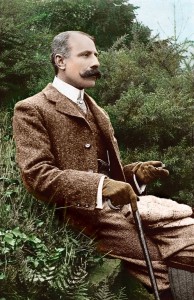 Edward Elgar fell out of fashion after World War I, and his existence was barely acknowledged by music historians for the next fifty years. He was so firmly associated with British Imperialism, that his music became the subject of sneers. This is particularly sad, because Elgar himself was a gentle, sensitive soul whose primary inspiration was nature, and he grew to loathe every performance of “Land of Hope and Glory”, the bombastic anthem that had been made from one of his marches. In the 1890’s he had been a very patriotic Empire booster, along with everyone else. But he was bitterly disilusioned by World War I and sought solace in his beloved English countryside. He never much cared for his role as Britain’s Official Composer.
Edward Elgar fell out of fashion after World War I, and his existence was barely acknowledged by music historians for the next fifty years. He was so firmly associated with British Imperialism, that his music became the subject of sneers. This is particularly sad, because Elgar himself was a gentle, sensitive soul whose primary inspiration was nature, and he grew to loathe every performance of “Land of Hope and Glory”, the bombastic anthem that had been made from one of his marches. In the 1890’s he had been a very patriotic Empire booster, along with everyone else. But he was bitterly disilusioned by World War I and sought solace in his beloved English countryside. He never much cared for his role as Britain’s Official Composer.
But despite all the scorn heaped on him, the First Symphony, the Cello Concerto, and the Enigma Variations continued to be performed in serious concerts, while the Pomp and Circumstance Marches lived on in the Pop Classics repertoire. The Second Symphony, not at first successful, slowly came to be played as often as the first. At his death, he left sketches for a third symphony, and in 1998, these were transformed into a complete work by the respected composer Anthony Payne.
The two complete symphonies have a number of influences, but that of Beethoven overwhelms all others. They are complex works, somewhat hard to follow unless you spot the (sometimes not obvious) variations of earlier thematic elements as they pop up again and again. The mood in both symphonies tends to alternate between a bear-like growling and a wistful, elegiac dreaminess. But unlike Beethoven, who occasionally interrupted the thunder for a brief meditative spell, Elgar was at heart a contemplative soul. You have a feeling that the blasts of brass and thumping drums were only there as a palisade to protect the elegiac passages.
The first symphony is one of the few successful symphonies in A‑flat. You might recognize its most prominent theme, as it was used in the movie Wallace & Gromit: The Curse of the Were-Rabbit. The second symphony is very similar in orchestration and technique, but it ends in a mild, dissipated elegy rather than the triumphant climax that Edwardian English audience were accustomed to, so in disappointed Elgar’s description, the audiences “sat around like stuffed pigs”. But it is now just as well-played and recorded as the first.
Payne’s reconstruction and filling out of the unfinished third symphony follows Elgar’s principles, and I think his understanding of the composer was sufficient to complete the work in a way that resembles what he had in mind. The orchestration strikes me as spot-on. The whole thing feels like Elgar, all right, but I think it feels a bit too much like the young, healthy Elgar. He was a lonely and saddened man in his old age, mourning the loss of a wife who had been a particularly close and spiritual partner. If he had been able to complete the third symphony, it would probably have taken a different, more painful turn. I don’t know whether the last bars were explicit in Elgar’s notes or not, but that transformation is definitely well-expressed in the ending as Payne presents it.
0 Comments.